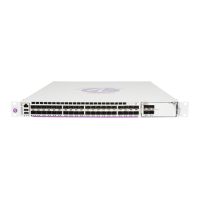VRRP
7705 SAR OS Router Configuration Guide 215
Owner and Non-owner VRRP
The owner has the same real IP address as the virtual router address and is responsible for
forwarding packets sent to this IP address. The owner assumes the role of the virtual router
master. Only one virtual router in the domain is configured as owner. All virtual router
instances participating in this message domain must have the same VRID configured.
VRRP on a 7705 SAR router can be configured to allow non-owners to respond to ICMP
echo requests if they become the virtual router master for the virtual router. Telnet and other
connection-oriented protocols can be configured for non-owner master response. However,
the individual application conversations (connections) do not survive a VRRP failover. A
non-owner VRRP router operating as a backup does not respond to any packets addressed to
any of the virtual router IP addresses.
The most important parameter defined on a non-owner virtual router instance is the priority.
The priority defines the virtual router selection order in the master election process. The
priority value and the preempt mode determine which virtual router becomes the virtual
router master.
Configurable Parameters
In addition to virtual IP addresses, to facilitate configuration of a virtual router on 7705 SAR
routers, the following parameters can be defined in owner configurations:
• VRID
• Message Interval and Master Inheritance
• VRRP Message Authentication
• Virtual MAC Address
The following parameters can be defined in non-owner configurations:
• VRID
• Priority
• IP Addresses
• Message Interval and Master Inheritance
• Master Down Interval
• Skew Time
• Preempt Mode
• VRRP Message Authentication
• Virtual MAC Address

